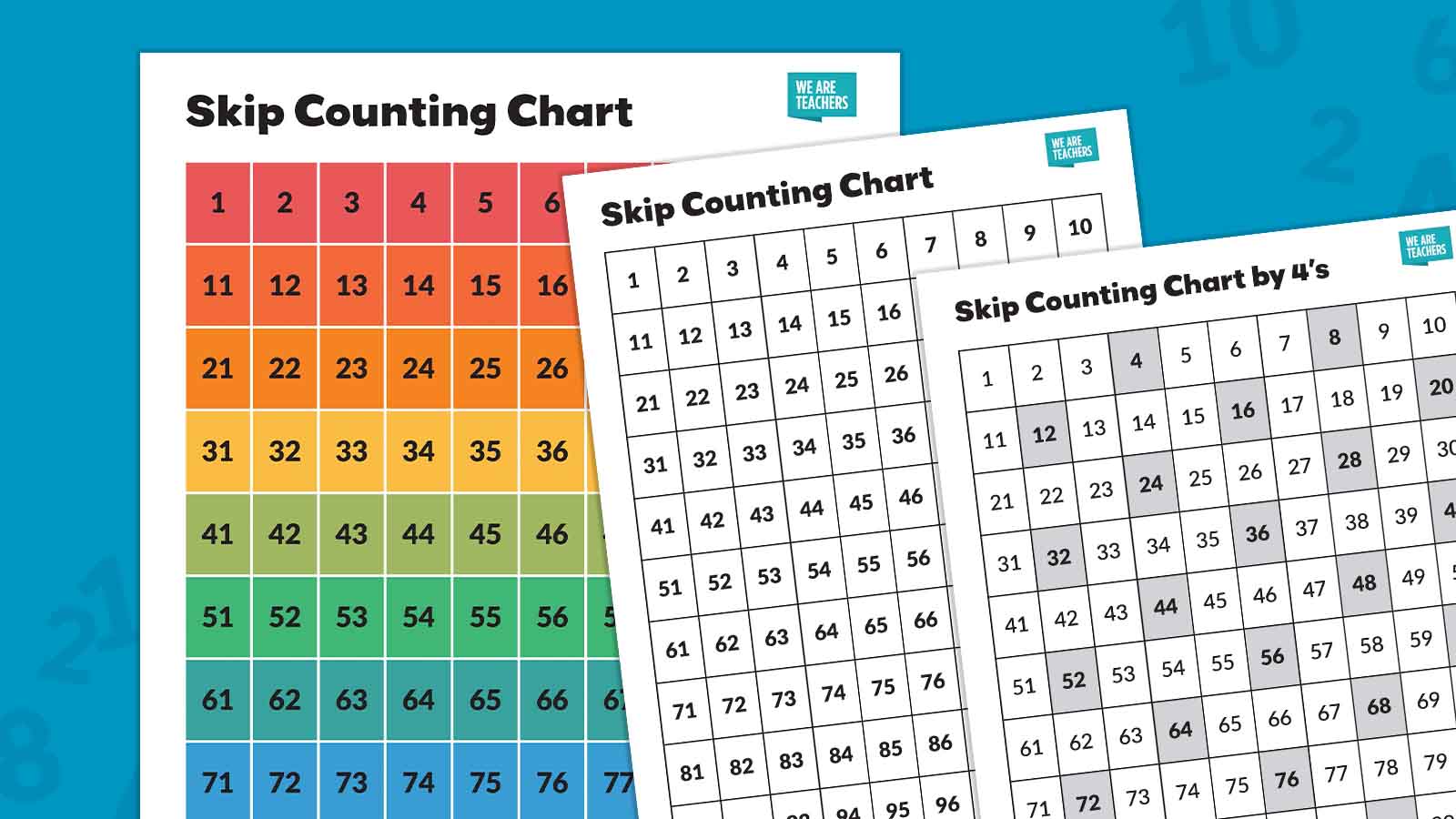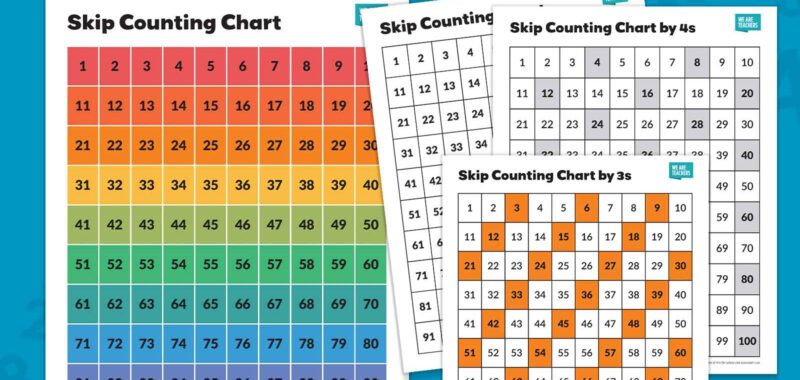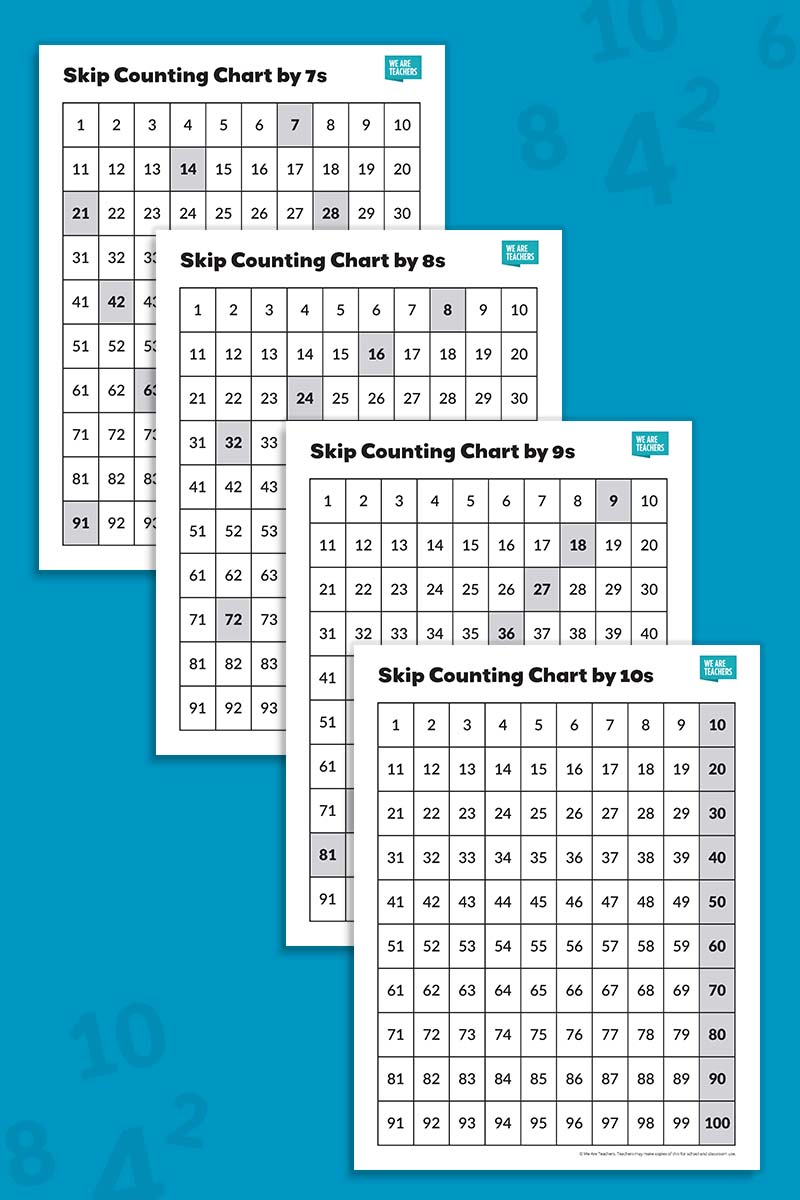Skip counting is fun for kids. Think about some of those early rhymes we learn like “Two, four, six, eight, who do we appreciate?” or “One, two, buckle my shoe; three, four, shut the door …” There’s something kind of fun about a skip-count. It’s an efficient, quick, and accurate way to count as well as foundational for multiplication.
Use this handy printable skip-counting chart bundle to help support an exploration of this important skill with the activities below.
Free Printable Skip-Counting Charts
The 100s charts in this bundle are the only ones you need to teach skip counting. You may find printable charts that show only the numbers needed to count by 2s, 5s, and 10s, but they’re not helpful from a learning perspective because they eliminate the actual skipping of numbers by the child. If a student can’t see the numbers, they can’t make a conscious decision to skip them. That’s why it’s best to use traditional 100 charts like those in this bundle, which encourage kids to truly understand the skill.
Skip-Counting Chart Activities
Begin skip-count learning by emphasizing oral skip-counts, so any errors are apparent and easily corrected. Let students use the charts to guide their counts and even touch the numbers as they count. Practice counting from the beginning of the chart, but also do some practice with different starting numbers. For example, when counting by 2s, you don’t always want to start with 2. You can start at 14 or 28 or 88. This helps kids use flexible thinking around the idea and prevents it from becoming entirely rote.
Introduction to Skip Counting
Use the skip-counting charts with shaded numbers when you first introduce the concept to students. You can skip-count along together using these charts.
What Are the Missing Numbers?
You can also use the skip-counting charts with shaded numbers to play What Are the Missing Numbers? Just take a sticky note and cut it into small squares, then use them to cover up a few of the numbers. Then have kids figure out which numbers are missing from the chart.
A Better Way To Count
Put out a collection of 14 similar-size books on the floor. Place them in pairs and spread them out. Have students sit in a circle around the books. Tell students, “Without touching the books, count them silently to yourself, and then raise your hand when you think you know how many there are.”
Give students a minute or two, then take responses by asking, “How many books are there? How did you get your answer?” Some students will count by 1s, some by 2s, and others will have a different method. Demonstrate and discuss how counting by 2s, a skip-count, is more efficient (quicker and more accurate) than counting by 1s.
Repeat the activity with more books, grouping them in 5s and 10s. Have students count and answer and then demonstrate how they skip-counted. You can record these patterns for all to see on black-and-white 100 chart papers with a highlighter.
What’s the Skip-Counting Pattern?
Make several copies of the black-and-white 100 chart for each student. Have students use a light-colored (yellow, orange, etc.) crayon, colored pencil, or highlighter. Tell students you will call out four numbers and that you will be skip counting as you do. Ask students to mark each number on their 100 chart and see if they can figure out what your skip-count pattern is. As soon as they know what the skip-counting pattern is, they should complete it on their papers by coloring in all the numbers on the chart to complete the pattern. Share answers by having students read and identify the pattern aloud. Try a variety of skip-counts including 2s, 3s, 4s, 5s, and 10s.
Skip-Count Partner Challenge
Partner students together and give each a black-and-white 100 chart. Each partner privately uses a light color to color in a skip-count pattern of their choice on the chart, but they leave out at least five numbers from the pattern. When finished with this step, partners trade papers and try to find all the missing numbers and color them in with a different color. Partners then compare the results and see if they agree. Once agreement is reached, have them try it again with new skip-count patterns on some new 100-chart papers.
Skip-Count Rhymes
A skip-count rhyme is fun to do. For example, a skip-count rhyme for 10s could be “10 = a big fat hen,” “20 = there’s plenty,” “30 = don’t get dirty,” “40 = don’t call me shorty,” “50 = looking nifty,” and so on.
To do this, give students blank 100 charts and lined papers. Share the skip-count rhyme above as an example. Ask students to create their own rhyme by first using the 100 chart to fill in only the numbers they will use for the skip-count rhyme. Five to ten numbers is plenty for a rhyme.
Then on the lined paper, ask each student to write each number in the rhyme with a sentence or phrase next to it that rhymes with the name of the number. The lines themselves don’t have to rhyme with each other. Remind students that they don’t need to use the whole chart—five to ten numbers are plenty for a rhyme. Have students share the rhymes aloud. These can make a very creative and fun-to-read bulletin board display.
What Comes Next?
Give each student a colored 100 chart. Tell them you are going to skip-count and when you stop, you want them to tell you what comes next. Begin skip-counting, but not at the beginning of the chart. Let’s say you are skip-counting by 5s. Don’t start at 5, rather start at 15 and begin counting, go to 40, and stop. Ask, “What comes next?” Do this three times with different skip-counts or the same skip-count (like by 5s) but starting at a different number. After a few of these, invite students to take turns doing the same thing leading the lesson. Even if they use the same skip-count patterns, they can always begin at a different starting point to keep it fresh.
Get your free printable Skip-Counting Chart bundle!

Just fill out the form on this page to grab your free bundle of all the skip-counting charts above.






